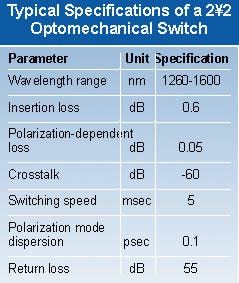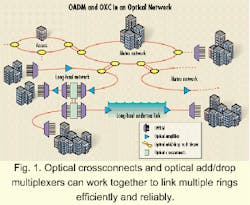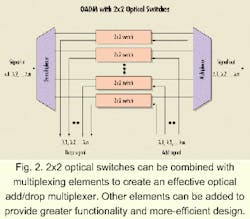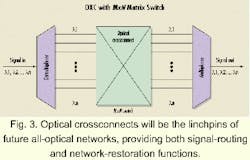Optical switches are key components in high-capacity, data-centric networks
Optical switches hold significant promise for future all-optical networks. But the technology behind these switches remains a matter of research.
The phenomenal growth in data-centric communications and the rapid rise of dense wavelength-division multiplexing (DWDM) technology have created a demand for more reliable and flexible means of network management. For example, the emergence of new requirements in metropolitan and access applications has led to the necessity for DWDM network topologies with add/drop and switching functions. As communication networks move toward an all-optical platform, the ability to optimize, route, protect, and restore networks in the optical realm becomes critical.
One of the most important fiber-optic components that seamlessly maintains network survivability and provides a flexible platform for signal routing is the optical switch. While most switching in communication systems today is accomplished electronically, emerging all-optical networks will require switches to route signals purely in the optical realm to achieve high-bit-rate and protocol-transparent networks.
A common function of optical switches in communication networks is restoration in the event of fiber breaks or transmitter failure. Most fiber-optic networks today have two or more fiber routes to key locations. Signals can be easily rerouted to the same destination by using a switch to avoid the faulty fiber or transmitter. But the speed at which signals are rerouted is critical to prevent loss of information, especially in high-speed telecommunications systems.
Another traditional use of optical switches is in network monitoring. In remote fiber test sites, multiple fibers can be connected to an optical time-domain reflectometer (OTDR) by using a 1xN switch for fiber-link monitoring. The switch is a cost-effective solution that enables the OTDR to test and detect the precise location of a cable fault in each fiber link. In networks that carry substantial traffic, the switch also allows a user to drop a signal or insert a network analyzer for real-time monitoring without disrupting network traffic.
Optical switches also are commonly used in fiber-optic component testing. Most optical component and system vendors require some form of switches for factory testing of components, cables, and subsystems in production or qualification applications. A multichannel switch, for example, is an invaluable tool for in-situ testing of fiber-optic components. This method enables many components--uninterrupted in a constant test environment--to be tested by monitoring each switch channel that corresponds to a specific test parameter. In-situ monitoring is rapidly becoming an important component testing method because of the invaluable information it yields about precise time-to-failure and device lifetime predictions.
A small but growing application for optical switches can also be found in fiber sensor networks. The optical switch is useful for directing light from multiple fiber Bragg grating-based sensing channels into an analyzer where wavelength deviations due to strains or temperature changes can be measured. The channels along the fibers are usually installed or embedded into structures or materials to provide self-sensing capabilities.
There are various types of optical switches commercially available today but the electro-optical and optomechanical models are most common.
Electro-optical switches consist of waveguides with electro-optic crystal materials such as lithium niobate. They usually include two branching waveguides arranged like 3-dB couplers on the input and output linked by two waveguide paths to form a Mach-Zehnder interferometer structure. This structure can achieve both 1x2 and 2x2 switching configurations. The differential phase between the two paths is controlled by voltage applied to one or both paths. The interference effect routes signals to the desired output as the drive voltage applied to one or both paths of the interferometer structure changes the phase differential between them.
Recently, waveguide switches made from barium titanate have been developed using a molecular beam epitaxy technique. These switches consist of silicon with magnesium-oxide deposits and appropriately configured electrodes. They generally use much less electric driving power than lithium-niobate switches.
The main advantage of electro-optical switches is switching speed, which is in the nanosecond range. Unfortunately, these switches have high insertion loss, high polarization-dependent loss, and high crosstalk. They are sensitive to electrical drift and generally require high operating voltage. Furthermore, electro-optical switches are nonlatching, which limits their applications in network protection and reconfiguration. Their high manufacturing cost also renders them unlikely for widespread commercial applications.
Optomechanical switches rely on mature optical technologies and are one of the most common types of switches currently in use. The principles of operation are fairly straightforward. Input optical signals are mechanically switched by moving fiber ends or prisms and mirrors to direct or reflect light to different output fibers in the switch. The mechanical movements can be solenoid driven and must be precise for proper alignment. Optomechanical switches can only achieve switching speeds in milliseconds, but they are widely used because of their low cost, simple design, and good optical performance.The Table shows the typical specifications of a 2x2 opto mechanical switch. These devices generally have low insertion loss (several 10ths of a decibel), low channel crosstalk, and good extinction ratio when used as on-off switches. Their polarization and wavelength-dependent losses can be very low. Because of their simple configuration, optomechanical switches are fairly insensitive to environmental variables such as temperature and humidity. They require low power and control voltage, and are often TTL compatible. Another advantage is that the switches are also available with latching functions.
Optomechanical switches are mostly available in 1x2 and 2x2 configurations. Small-scale matrix nonblocking MxN optical switches can easily be built, and large-scale (such as 64x64) partially blocking switches are possible using multistage configurations. But large-scale, completely nonblocking matrix switches are difficult to assemble because of their complexity and the number of moving mechanical parts involved.
There are other optical switches based on emerging thermal, liquid-crystal, acoustic, and micro-electromechanical (MEM) technologies.
Thermal-optic switches rely on thermally tunable polymer waveguides that are fabricated within polymer stacks spin-cast on silicon wafers. Switching is controlled by thin-film heating elements deposited in the polymer stacks. As an electrical current passes through the heaters, it creates a lateral thermal gradient across the waveguide branching region and changes the refractive index in the waveguide. Such changes direct the optical coupling between the main guide and the desired branch guide. These optical switches are compact in size and can achieve microsecond switching speed. But their drawbacks are high insertion loss, poor crosstalk, low extinction ratio, high power consumption, and a requirement for proper thermal dissipation.
Liquid-crystal optical switches consist of liquid-crystal cells and polarization beam splitters (PBS) or beam shifters in their design. The purpose of the crystal cell is to rotate the polarization angle of the input beam. When the cell's electrode receives no applied voltage, a 90° polarization rotation angle is applied to a light beam passing through the cell. When voltage is applied, the light beam will pass without any change to its state of polarization. The PBS or beam shifters act as routers that direct signals to the desired ports. This technology allows both matrix polarization-sensitive and -insensitive switches to be made.
The speed of such switches is about 100 msec using nematic liquid crystals and 10 microsec with ferroelectric liquid crystals. The technology enables multiple-channel switches to be fabricated, but the disadvantages are high loss, considerable thermal drift, large crosstalk, and expensive driving circuitry.
A third type of optical switch is based on acousto-optic technology. This technology accurately directs light from one fiber to another by relying on a transverse acoustic wave applied to an optical medium such as TeO2 crystal. Light passing through the medium is diffracted by a certain angle because the acoustic wave acts like a grating to modulate the refractive index of the medium. The angle of diffraction depends on the frequency of the applied acoustic field and wavelength.
Acousto-optic switches can achieve switching speeds in microseconds. This technology can be easily used to build switches with low port count. But it is not flexible for configuring matrix switches due to the complicating system of operation necessary to control switching through frequency changes. There is also a problem with large wavelength-dependent loss, and the driving circuitry is costly.
Another interesting switch concept is based on MEM technology that regulates light beams in free space. Different MEM switch concepts have been explored using different types of special micro-optic components actuated by miniaturized mechanical systems such as piezoelectric actuators, micromachined actuatable platform, or moving fiber structure.
One example of such a switch is based on MEM vertical torsion mirrors. The switch consists of integrated electrostatically operated torsion mirrors in a silicon substrate. The tiny mirrors-measuring just hundreds of microns in size-are supported by thin torsion beams above a through-hole formed in the substrate to redirect incident light in free space. With an applied voltage of about 80V, switching speeds of 400 microsec have been recorded.
Switching also can be realized by moving fibers with bistable operation. This design relies on V-grooves for precise alignment of the optical fibers. The fabrication process is based on bulk anisotropic Si etching for thermal actuators with cross sections of 80x150 microns2. The switching speed is less than 10 msec.
MEM-based switches are attractive because of their miniaturization, integration, and potential for mass production just like fabricated integrated circuits. But significant efforts are still required to develop a manufacturing process to make MEM a viable and profitable alternative technology. In addition, much work remains to improve the interface between the input and output fibers and MEM switching elements.
Beyond the traditional applications, optical switches will play an increasingly critical role in emerging multichannel and reconfigurable photonic networks. Enabling the all-optical network will require technologies such as DWDM, optical add/drop multiplexers (OADMs), and optical crossconnects (OXCs).
Up until now, DWDM has been the primary all-optical network element deployed in long-haul and emerging metropolitan communication applications. Introducing both OADM and OXC elements will enable flexible use and allocation of wavelengths in a network environment that has users constantly on the rise. These network elements provide carriers the ability to reconfigure network traffic for optimal data transport and achieve rapid restoration in the event of a link failure-all within the optical layer. The reality of the all-optical network will eventually make many of the slow and expensive optical-electrical conversions obsolete, thus enabling future networks to run more quickly and economically.Both OADMs and OXCs require extensive optical-switching capabilities. Figure 1 shows how these elements potentially fit into an optical network.
By relying on an optical switch, an OADM can pick a specific wavelength from a WDM signal and drop the wavelength at a given point in the network. It can then replace the dropped signal with a new signal at the same wavelength for onward transmission to the next node. This capability greatly enhances payload management in the all-optical network.OXCs are dynamic switching fabrics with connections between any of the M fiber inputs and any of the N fiber outputs in a DWDM network (see Fig. 3). Thus, optical-crossconnect switches have nonblocking, one-to-many connections in a matrix configuration. OXCs provide excellent network survivability, lower network-management cost, and reconfigurable paths for signal routing in the optical layer, thus eliminating the need for complex and expensive digital switches. Since they operate in the optical realm, optical crossconnects can potentially accommodate terabit data streams due to their wavelength, bit-rate, and protocol-transparent characteristics.
Despite the variety of optical switches discussed here, new or improved switch technologies will continue to emerge because of the increasingly stringent speed, performance, and reliability requirements for OADM and OXC applications. One of the more interesting and recent technology concepts is the idea of an all-optical switching device that relies on the large nonlinearity in an optical fiber. An example is the use of a nonlinear directional coupler as the optical switch. The coupler consists of two closely spaced fiber cores which exchange energy via the evanescent field. Its coupling length is carefully defined so that a low-intensity signal completely couples from one core to another after traveling a certain length. But when a high-intensity signal is launched into one of the cores, the propagation constant changes due to the nonlinear dependence of refractive index on intensity. Thus, an on-off switching effect is achieved as the two fiber cores become uncoupled because of phase mismatch. Since switching is accomplished within the fiber, there is potential for this type of all-optical switch in future optical networks because of its high switching speeds (in femtoseconds), low loss, and high cascadability for matrix configurations.
Development of high-speed, high-performance switches is inevitable as optical-network capacity continues to expand and electronic switches can no longer manage beyond multigigabit speeds. The all-optical network will become reality when more-efficient means of signal management are available. Optical switches will play a key role in enabling future high-capacity optical networks.
Ronnie Chua is marketing-communications manager and Yiqun Hu is application engineer at E-TEK Dynamics (San Jose, CA). Questions can be directed to [email protected]



